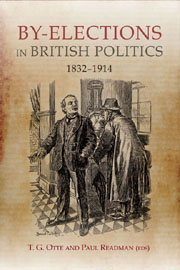Book contents
- Frontmatter
- Contents
- List of Figures and Tables
- List of Contributors
- Preface and Acknowledgements
- List of Abbreviations
- Introduction
- 1 ‘Plumping Contests’: The Impact of By-elections on English Voting Behaviour, 1790–1868
- 2 Government Appointment By-elections: 1832–86
- 3 ‘We should have had 1,000’: The By-elections of the 1874 Parliament
- 4 ‘The Glamour of Independence’: By-elections and Radicalism during the Liberal Meridian, 1869–83
- 5 ‘The Swing of the Pendulum at Home’: By-elections and Foreign Policy, 1865–1914
- 6 By-elections and the Modernisation of Party Organisation, 1867–1914
- 7 ‘A Terrific Outburst of Political Meteorology’: By-elections and the Unionist Electoral Ascendancy in Late-Victorian England
- 8 Land Reform and By-elections, 1885–1914: Do By-elections Matter?
- 9 Edwardian By-elections
- 10 Lloyd George, Limehouse and the Realignment of British Politics: The Bermondsey By-election of 1909
- 11 By-elections and the Peculiarities of Scottish Politics, 1832–1900
- Index of By-election Contests
- General Index
11 - By-elections and the Peculiarities of Scottish Politics, 1832–1900
Published online by Cambridge University Press: 05 May 2013
- Frontmatter
- Contents
- List of Figures and Tables
- List of Contributors
- Preface and Acknowledgements
- List of Abbreviations
- Introduction
- 1 ‘Plumping Contests’: The Impact of By-elections on English Voting Behaviour, 1790–1868
- 2 Government Appointment By-elections: 1832–86
- 3 ‘We should have had 1,000’: The By-elections of the 1874 Parliament
- 4 ‘The Glamour of Independence’: By-elections and Radicalism during the Liberal Meridian, 1869–83
- 5 ‘The Swing of the Pendulum at Home’: By-elections and Foreign Policy, 1865–1914
- 6 By-elections and the Modernisation of Party Organisation, 1867–1914
- 7 ‘A Terrific Outburst of Political Meteorology’: By-elections and the Unionist Electoral Ascendancy in Late-Victorian England
- 8 Land Reform and By-elections, 1885–1914: Do By-elections Matter?
- 9 Edwardian By-elections
- 10 Lloyd George, Limehouse and the Realignment of British Politics: The Bermondsey By-election of 1909
- 11 By-elections and the Peculiarities of Scottish Politics, 1832–1900
- Index of By-election Contests
- General Index
Summary
At every election since the Reform Bill of 1832, Liberal opinions have prevailed at the polls in Scotland. Sometimes the Liberal majority has been overwhelming, at other times less considerable, but always substantial; and the representatives have fairly reflected the opinions of the constituencies, for in no part of the United Kingdom of the same size and importance have democratic opinions prevailed for so considerable a period. It is, perhaps, due to this fact that Scotland has been chosen as the battle-ground on which recent political campaigns have been carried on. The Conservative leaders frequently attacking the citadel of their opponents' power – and the Liberal leaders returning to repel the attack, and to receive encouragement from the enthusiasm of their followers – both acknowledge Scotland to be the stronghold of Liberalism. If this be so, it may be worth considering for a little whether we can find an answer to the question – Why is Scotland Liberal?
This article was penned in 1888 in the midst of a series of fiercely contested by-elections in Scotland, largely centred on the conflict of Liberals and Liberal Unionists, but including Keir Hardie's celebrated yet electorally insignificant challenge for Mid-Lanark. Such commentary was fairly typical of a frequently-stated encapsulation of Scottish political difference across the nineteenth century. By the 1880s the question of why Scotland was so consistently Liberal in electoral terms was almost as hackneyed as the jibe that all Conservative MPs could fit in a single first-class train compartment.
- Type
- Chapter
- Information
- By-Elections in British Politics, 1832-1914 , pp. 273 - 292Publisher: Boydell & BrewerPrint publication year: 2013



